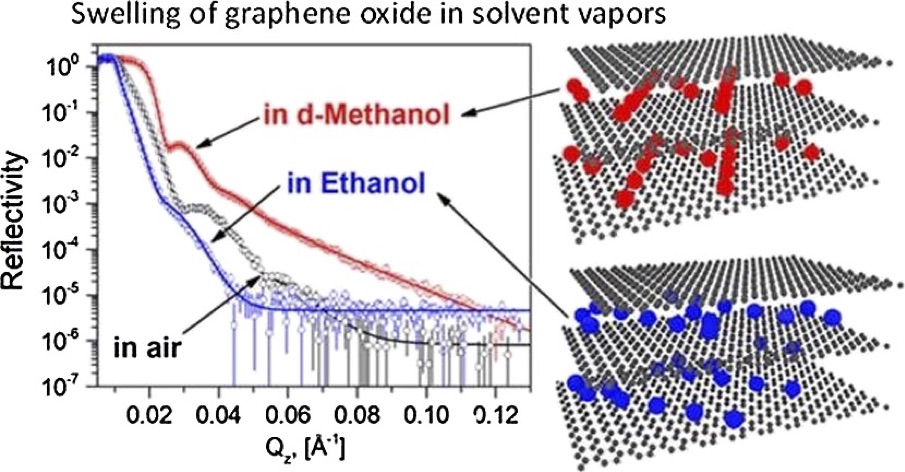Why?
Multilayered Graphene Oxide (GO) materials such as membranes and thin films are known for their potential for selective ion permeation, nano-filtration, water desalination and gas barrier properties. Many recent studies have aimed at demonstration of selective permeation of certain ions and molecules through GO membranes. Membrane tests were demonstrated to be successful for relatively thin GO laminates with a thickness of only 4−300 nm. Very thin (∼1 nm) GO films have been reported recently to exhibit extraordinary gas separation properties. The vapor permeation properties of GO membranes are defined by their swelling properties. The GO structure expands in polar solvents which results in increase of the interlayer distance and formation of a labyrinth path of interconnected “channels”. Therefore, GO film/membrane structure expansion and quantitative estimation of solvent sorption are important parameters which allow to understand the permeation mechanism and needs to be studied.
How?
Recently, we demonstrated that neutron scattering can be used as a powerful tool for studies of solvent sorption by thin GO films. Neutron reflectivity (NR) provides simultaneous determination of the GO unit cell volume and its chemical composition (Figure 1). Therefore, the exact amount of the solvent sorbed by the GO thin film can be evaluated. Using isotopic contrast, this method allowed also to distinguish insertion of solution components into the GO structure, providing information about selectivity in vapor sorption.

Figure 1. Using NR of the GO film for evaluation of selectivity in sorption from the binary vapor mixture. Reflectivity plot: black - GO film in air, blue - GO film intercalated ethanol, red - GO film intercalated d-methanol; solid lines represent best-fit model curves.
Who?
This project is led by Dr. Alexandr Talyzin at the department of Physics at Umea University, Sweden in collaboration with scientists at SuperADAM beamline at Institute Laue-Langevin (ILL), France.
What's next?
Neutron reflectivity (NR) technique was used to evaluate the amount of solvents intercalated into thin GO films from vapors of several liquid solvent mixtures including ethanol/d-methanol, D2O/dimethylformamide (DMF), D2O/dimethyl sulfoxide (DMSO), and D2O/acetonitrile.
Further experiments are planned to study sorption of molecules and ions by GO films using aqueous solutions relevant to energy storage applications.
Contact: Dr Alexandr Talyzin
alexandr.talyzin@umu.seUmeå University
This project is funded via theEuropean Union’s Horizon 2020 research and innovation program under grant agreement no. 696656, the Swedish Research Council and Kempestiftelserna.
